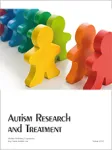[article]
| Titre : |
Gait Symmetry in Children with Autism |
| Type de document : |
texte imprimÃĐ |
| Auteurs : |
Victoria L. CHESTER, Auteur ; Matthew CALHOUN, Auteur |
| AnnÃĐe de publication : |
2012 |
| Article en page(s) : |
5 p. |
| Langues : |
Anglais (eng) |
| Index. dÃĐcimale : |
PER Périodiques |
| RÃĐsumÃĐ : |
Most studies examining gait asymmetry have focused on infants and toddlers and have tended to use subjective methods of evaluating movement. No previous studies have examined gait symmetry in older children with autism using objective motion capture systems. The purpose of this paper was to quantify gait symmetry in children with autism versus age-matched controls. Fourteen children with autism ( �� = 1 4 ) and twenty-two ( �� = 2 2 ) age, height, and weight-matched controls participated in the study. An eight camera Vicon motion capture system and four Kistler force plates were used to compute temporal-spatial parameters and symmetry indices during walking. Group differences in these measures were tested using MANOVAs. No significant differences between the autism and control group were found for any of the temporal-spatial measures or symmetry indices. Therefore, results suggest that children with autism demonstrate typical symmetry or interlimb movement during gait. Further research is needed to examine the use of different gait inputs to the symmetry indices (e.g., joint angles and moments). A greater awareness of the movement patterns associated with autism may increase our understanding of this disorder and have important implications for treatment planning. |
| En ligne : |
http://dx.doi.org/10.1155/2012/576478 |
| Permalink : |
https://www.cra-rhone-alpes.org/cid/opac_css/index.php?lvl=notice_display&id=178 |
in Autism Research and Treatment > (March 2012) . - 5 p.
[article] Gait Symmetry in Children with Autism [texte imprimÃĐ] / Victoria L. CHESTER, Auteur ; Matthew CALHOUN, Auteur . - 2012 . - 5 p. Langues : Anglais ( eng) in Autism Research and Treatment > (March 2012) . - 5 p.
| Index. dÃĐcimale : |
PER Périodiques |
| RÃĐsumÃĐ : |
Most studies examining gait asymmetry have focused on infants and toddlers and have tended to use subjective methods of evaluating movement. No previous studies have examined gait symmetry in older children with autism using objective motion capture systems. The purpose of this paper was to quantify gait symmetry in children with autism versus age-matched controls. Fourteen children with autism ( �� = 1 4 ) and twenty-two ( �� = 2 2 ) age, height, and weight-matched controls participated in the study. An eight camera Vicon motion capture system and four Kistler force plates were used to compute temporal-spatial parameters and symmetry indices during walking. Group differences in these measures were tested using MANOVAs. No significant differences between the autism and control group were found for any of the temporal-spatial measures or symmetry indices. Therefore, results suggest that children with autism demonstrate typical symmetry or interlimb movement during gait. Further research is needed to examine the use of different gait inputs to the symmetry indices (e.g., joint angles and moments). A greater awareness of the movement patterns associated with autism may increase our understanding of this disorder and have important implications for treatment planning. |
| En ligne : |
http://dx.doi.org/10.1155/2012/576478 |
| Permalink : |
https://www.cra-rhone-alpes.org/cid/opac_css/index.php?lvl=notice_display&id=178 |
|  |


